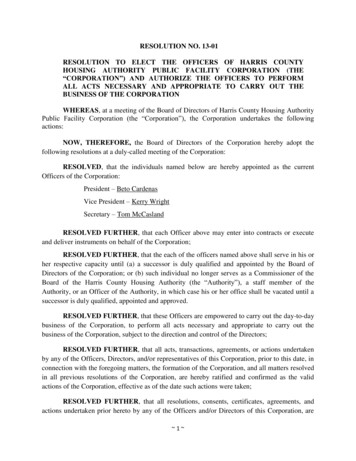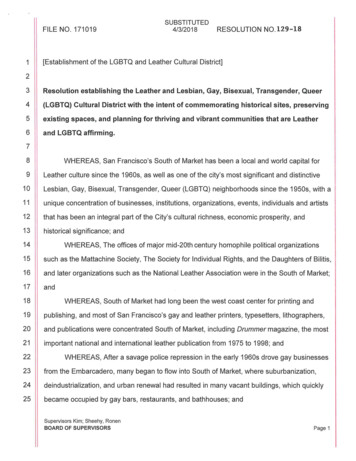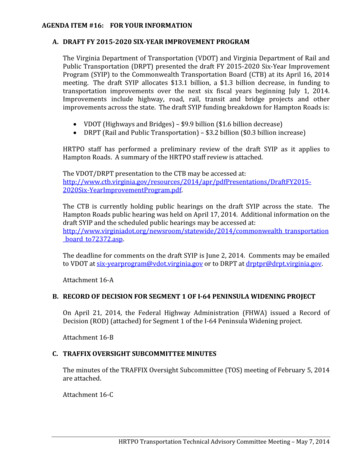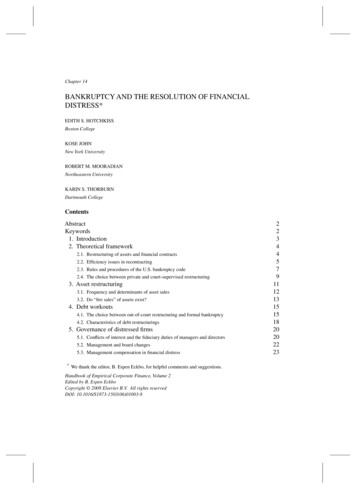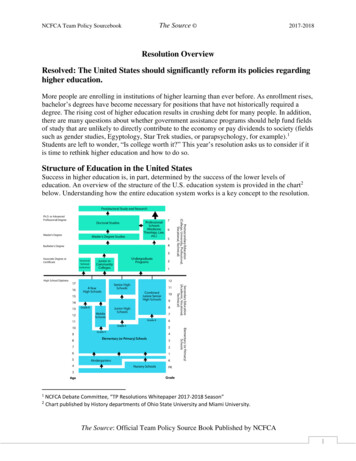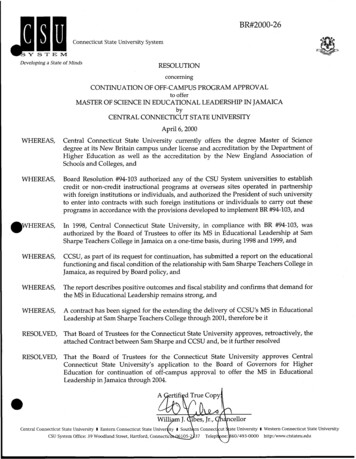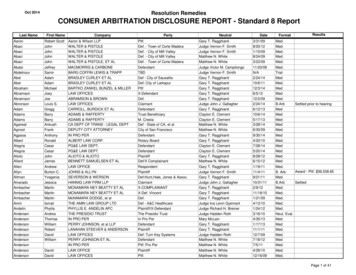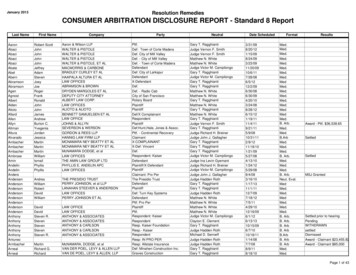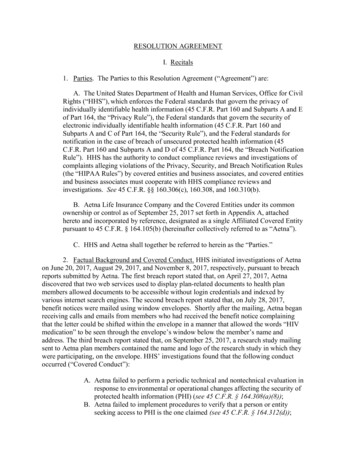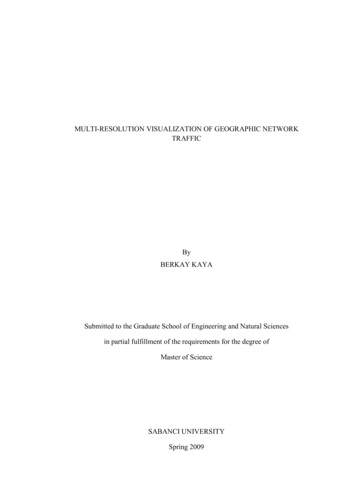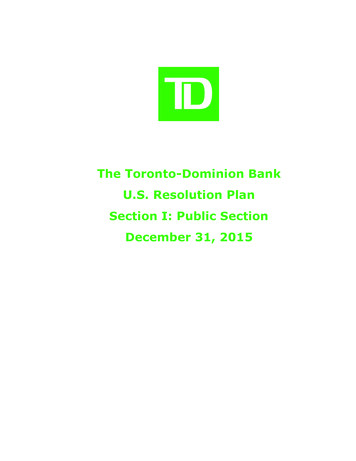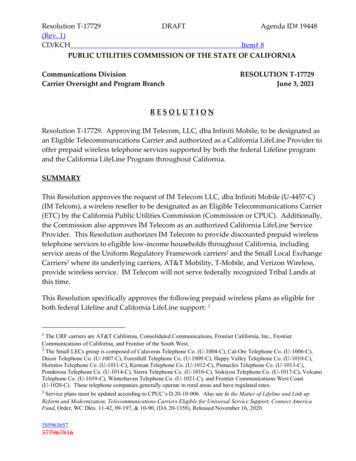
Transcription
Resolution T-17729DRAFTAgenda ID# 19448(Rev. 1)CD/KCHItem# 8PUBLIC UTILITIES COMMISSION OF THE STATE OF CALIFORNIACommunications DivisionCarrier Oversight and Program BranchRESOLUTION T-17729June 3, 2021RESOLUTIONResolution T-17729. Approving IM Telecom, LLC, dba Infiniti Mobile, to be designated asan Eligible Telecommunications Carrier and authorized as a California LifeLine Provider tooffer prepaid wireless telephone services supported by both the federal Lifeline programand the California LifeLine Program throughout California.SUMMARYThis Resolution approves the request of IM Telecom LLC, dba Infiniti Mobile (U-4457-C)(IM Telcom), a wireless reseller to be designated as an Eligible Telecommunications Carrier(ETC) by the California Public Utilities Commission (Commission or CPUC). Additionally,the Commission also approves IM Telecom as an authorized California LifeLine ServiceProvider. This Resolution authorizes IM Telecom to provide discounted prepaid wirelesstelephone services to eligible low-income households throughout California, includingservice areas of the Uniform Regulatory Framework carriers1 and the Small Local ExchangeCarriers2 where its underlying carriers, AT&T Mobility, T-Mobile, and Verizon Wireless,provide wireless service. IM Telecom will not serve federally recognized Tribal Lands atthis time.This Resolution specifically approves the following prepaid wireless plans as eligible forboth federal Lifeline and California LifeLine support: 31The URF carriers are AT&T California, Consolidated Communications, Frontier California, Inc., FrontierCommunications of California, and Frontier of the South West.2The Small LECs group is composed of Calaveras Telephone Co. (U-1004-C), Cal-Ore Telephone Co. (U-1006-C),Ducor Telephone Co. (U-1007-C), Foresthill Telephone Co. (U-1009-C), Happy Valley Telephone Co. (U-1010-C),Hornitos Telephone Co. (U-1011-C), Kerman Telephone Co. (U-1012-C), Pinnacles Telephone Co. (U-1013-C),Ponderosa Telephone Co. (U-1014-C), Sierra Telephone Co. (U-1016-C), Siskiyou Telephone Co. (U-1017-C), VolcanoTelephone Co. (U-1019-C), Winterhaven Telephone Co. (U-1021-C), and Frontier Communications West Coast(U-1020-C). These telephone companies generally operate in rural areas and have regulated rates.3 Service plans must be updated according to CPUC’s D.20-10-006. Also see In the Matter of Lifeline and Link upReform and Modernization, Telecommunications Carriers Eligible for Universal Service Support, Connect AmericaFund, Order, WC Dkts. 11-42, 09-197, & 10-90, (DA 20-1358), Released November 16, 2020.385963657377967816
Resolution T-17729CD/KCH DRAFTJune 3, 2021Basic Plan – Unlimited voice and text with 4.5 GB data for 0 per month (Free newhandset) Retail price: 24.10.Standard Plan - Unlimited voice and text with 6 GB data for 0 per month (Free newhandset) Retail Price: 28.10.IM Telecom’s rate plans are subject to a 39 activation fee, which the company will seekreimbursement from the California LifeLine Program for eligible households. IM Telecomis responsible for any activation/connection fee that is not eligible for reimbursement fromthe California LifeLine Program.4IM Telecom’s Advice LetterOn August 8, 2019, IM Telecom submitted Tier 3 Advice Letter (AL) 7 to the CPUCrequesting ETC designation to offer prepaid wireless services to low-income householdsthrough the California LifeLine Program and federal Lifeline program. 5 IM Telecom doesnot seek federal high-cost fund support.On December 11, 2019, IM Telecom filed supplement AL 7A to update information on theunderlying service providers and service areas and a change in company management.On February 23, 2021, IM Telecom filed supplement AL 7B at Staff’s request to update itsservice offerings consistent with CPUC Decision 20-10-006.BACKGROUNDFederal ETC Designation RequirementsIn order to receive federal universal service support, an applicant must be designated as anETC. Section 254(e) of the federal Telecommunications Act of 1996 (the Act) states that“only an eligible telecommunications carrier under section 214(e) shall be eligible to receivespecific federal universal service support.”6State commissions are given the primary responsibility for designating ETCs in their states.Section 214(e)(2) of the Act states that, “[u]pon request and consistent with the publicinterest, convenience, and necessity, the state commission may, in the case of an area4IM Telecom AL 7B, p. 4.5IM Telecom AL 7, p. 2.647 C.F.R. §§ 54.400 et seq. contains the Federal Communications Commission’s (FCC) Lifeline rules issued toimplement § 254 of the Act.2
Resolution T-17729CD/KCHDRAFTJune 3, 2021served by a rural telephone company, and shall, in the case of all other areas, designatemore than one common carrier as an eligible telecommunications carrier for a service areadesignated by the state commission”7 so long as the requesting carrier meets therequirements of Section 214(e)(1).Section 214(e)(1) of the Act provides that, a common carrier designated as an ETC mustoffer services supported by the federal Universal Service Fund (USF) throughout thedesignated service area either by using its own facilities, resale, or by a combination of itsown facilities and resale of another carrier’s services and must advertise the services andthe related charges using advertising media of general distribution throughout thedesignated service area.8 Advertising must include the availability of federal Lifelineservices in a manner reasonably designed to reach those likely to qualify for those services.In addition to meeting the public interest standard, the FCC rules require that a carrierrequesting ETC designation must:1. Certify that it will comply with the service requirements applicable to thesupport that it receives;2. Submit a five-year plan that describes proposed improvements or upgrades tothe applicant’s network throughout its proposed service area. Wirelessapplicants providing Lifeline-only service are not required to submit a five-yearplan; 93. Demonstrate its ability to remain functional in emergency situations;4. Demonstrate that it will satisfy applicable consumer and service qualitystandards; 105. Demonstrate that it is financially and technically capable of providing the federalLifeline service, specifically whether the applicant previously offered services tonon-Lifeline consumers, how long it has been in business, whether the applicantintends to rely exclusively on USF disbursements to operate, whether theapplicant receives or will receive revenue from other sources, and whether it has747 USC § 214(e)(2).847 USC § 214(e)(1).9 See Inthe Matter of Lifeline and Link-up Reform and Modernization, Lifeline and Link-up, Federal-State Joint Board onUniversal Service, Advancing Broadband Availability Through Digital Literacy Training, Report and Order and FurtherNotice of Proposed Rulemaking, WC Dkt Nos. 11-42, 03-109, and 12-23, and CC Dkt. 96-45 (FCC 12-11), releasedFebruary 6, 2012, para. 386.10 Id., ¶389. Also see 47 C.F.R. § 54.422 – Annual reporting for ETCs receiving low-income support. Also see G.O. 133D, §4.3
Resolution T-17729CD/KCHDRAFTJune 3, 2021been subject to any enforcement action or ETC revocation proceedings in anystate; and116. Submit information describing the terms and conditions and rates of any voicetelephone service plans offered to federal Lifeline participants. Wirelessapplicants must comply with the Cellular Telecommunications and InternetAssociation’s Consumer Code for wireless service. 12CPUC ETC Designation RequirementsA carrier seeking an ETC designation also must comply with CPUC’s ETC rules. InResolution T-17002 (May 25, 2006), the CPUC adopted The Comprehensive Procedures andGuidelines for ETC Designation and Requirements for ETCs that are consistent with FCCUniversal Service Order 97-15713 regarding designation of a telephone carrier as a qualifiedETC. Pursuant to this Resolution, applicants seeking ETC designation in California arerequired to provide the following:1.2.3.4.5.6.7.A description of the proposed service offerings and attached service area maps;A description of the advertising plan(s);A statement of commitment to provide service;Submission of the 2-year service quality improvement plan;A showing of the ability to remain functional in emergencies;A statement of commitment to consumer protection;Demonstration that a carrier’s usage plan is comparable to that of the incumbentLEC in the proposed service area; and8. A public interest determination.In addition to Resolution T-17002 ETC designation rules (or its successor), carriersrequesting ETC designation must also comply with General Order (GO) 153 and all relatedCalifornia LifeLine Program rules, orders, decisions, resolutions, and federal Lifeline rules.Carriers must also comply with CPUC User Fee and surcharge obligations.14 The CPUCUser Fee is levied on all telecommunications carriers providing services directly tocustomers and the amount of fees is a percentage calculation based on all intrastatecustomer billings for telecommunications services. All telecommunications service11Id., ¶¶387-388.1247 C.F.R. §§ 54.201 and 54.202(a).13See In the Matter of Federal-State Joint Board on Universal Service, Report and Order, CC Dkt. 96-45 (FCC 97-157),released May 8, 1997.14 See: https://www.cpuc.ca.gov/General.aspx?id 11244
Resolution T-17729CD/KCHDRAFTJune 3, 2021providers are also required to collect and remit public purpose program surcharges fromend-users. These surcharges fund the CPUC’s universal service programs.California LifeLine Program RequirementsThe purpose of the California LifeLine Program is to provide high quality, residentialtelephone service at affordable rates to low-income citizens of California. The CaliforniaLegislature directed the CPUC to ensure that the program has essential consumerprotections and is competitively neutral. A carrier seeking to be a California LifeLineprovider must comply with the CPUC’s California LifeLine rules and requirements setforth in Public Utilities Code § 871 et seq., GO 153, and various CPUC decisions including,but not limited to, D.20-10-006, D.17-01-032, D.14-01-036 and D.10-11-033. The carrier alsomust comply with all applicable CPUC rules, orders, decisions, resolutions, the PublicUtilities Code, and federal Lifeline rules.In order to become a California LifeLine provider, a carrier must generally demonstrate thefollowing:1) It has a valid, active operating authority issued by the CPUC;152) It is current in its remittance of CPUC User Fees and public purpose programsurcharges;163) Its proposed offerings meet the CPUC’s California LifeLine service elements;174) Its disclosures, schedule of rates and charges, and terms and conditions arethorough and consistent with state and federal rules;5) Its marketing and selling methods are consistent with D.14-01-036 and 47 C.F.R. §54.405(b); and6) Its provisioning process is consistent with and in compliance with the CaliforniaLifeLine Administrator’s enrollment process, validation checks, transmissionrequirements, and efforts to prevent waste, fraud, and abuse.1815See OP 3 of D.14-01-036.16See GO 153 §§ 9.5.3.1., 9.8.5, 9.8.6, 9.9.2, 10, and 11 and Ordering Paragraph 21 of D.13-05-035.17See OP 26.a. of D.14-01-036, Attachment D, See also GO 153, Appendix A as adopted in D.14-01-036.18On February 14, 2014, the CPUC’s Communications Division issued an administrative letter titled“Guidance for Service Providers Interested in Offering California LifeLine Wireless Services Consistent withDecision 14-01-036.”(Administrative 20-0BE4-4811-B545-64AF0349382F/0/CDAdvice Letter Filing Components CaLLWireless APPROVED 021414.pdf). This Administrative Letter provides instructions and guidance for acarrier seeking to become a California LifeLine provider to offer California LifeLine wireless services.5
Resolution T-17729CD/KCHDRAFTJune 3, 2021When a wireless telecommunications carrier becomes a California LifeLine provider, it isauthorized to provide California LifeLine services statewide without any geographicrestrictions.A wireless carrier also must demonstrate that its proposed offerings meet the CaliforniaLifeLine wireless service elements. The CPUC adopted the California LifeLine wirelessservice elements in D.14-01-036, set forth in GO 153, Appendix A-2. Some of the keyservice elements are as follows: The provider must offer participants the ability to place and receive voice-gradecalls over all distances using the public switched telephone network or successornetwork;The provider must offer free, unlimited access to public safety N11s (211, 311, 511,711, and 811) for California LifeLine eligible plans with 1,000 or more voice minutes,and to 911 emergency services for all California LifeLine eligible plans;The provider must offer services on a non-discriminatory basis to any customerresiding in the service territory;The provider must offer to California LifeLine participants all handsets on the samebasis as it offers to retail customers;The provider must offer all plans that meet or exceed the California LifeLine serviceelements and are consistent with the rules on a discounted basis; andThe provider must provide free, unlimited access to customer servicerepresentatives in the same language in which the California LifeLine service wasoriginally sold or marketed.In addition, the wireless carrier must comply with the California LifeLine wireless serviceterms and conditions adopted in D.14-01-036, set forth in GO 153, Appendix A-2,including, but not limited to: The provider must exempt participants from paying CPUC User Fees,surcharges, and taxes;The provider must not assess a fee to participants for paying their bills in personby cash, check, or other forms of payment;The provider must allow participants to terminate service without incurringearly termination fees; andThe provider must allow participants to return their handsets within three daysof service activation for free, without incurring a restocking fee.To ensure that participants are adequately informed of the service plans, the CaliforniaLifeLine provider must prominently disclose and disseminate terms and conditions,program information, and enrollment process to potential and existing participants in6
Resolution T-17729CD/KCHDRAFTJune 3, 2021compliance with rules including, but not limited to, GO 153, Sections 4 and 5, D.14-01-036,D.20-10-006, Public Utilities Code § 876, and 47 C.F.R. §54.405(c). Additionally, serviceproviders must submit their marketing materials, including scripts, to the CommunicationsDivision (CD) for review and approval prior to dissemination and/or availability to thepublic.19Notice/ProtestsIM Telecom served its AL 7 filing via email to all parties on the ETC service list and the AL7 appeared in the Commission’s Daily Calendar on August 14, 2019. No protests werefiled.DISCUSSIONThis Resolution recommends approval of IM Telecom, LLC, dba Infiniti Mobile, to bedesignated as an Eligible Telecommunications Carrier and authorized as a CaliforniaLifeLine Provider to offer prepaid wireless telephone services supported by both thefederal Lifeline program and the California LifeLine Program throughout California.Company OverviewIM Telecom is an Oklahoma limited liability company with its principal office located at13601 Preston Road, Suite 816E, Dallas, TX 75249. On December 1, 2015, IM Telecomreceived its Wireless Identification Registration (“WIR”) number U-4457-C to provideresold wireless service. As a registered Commercial Mobile Radiotelephone Service(CMRS) provider in California, IM Telecom is required to report and pay public purposeprogram surcharges and user fees on its California intrastate telecommunications servicesrevenues.IM Telecom was recently acquired in 2019 by KonaTel, Inc., a Nevada corporation. Theparent company as known as KonaTel, Inc., is a public Delaware corporation, that whollyowns IM Telecom, KonaTel Inc. and Apeiron Systems, Inc. KonaTel, Inc. is also aregistered CMRS provider in California, with WIR number U-4482-C.Compliance with Federal ETC RequirementsA carrier must satisfy all federal ETC requirements in order to receive an ETC designation.IM Telecom has met the following federal ETC requirements:19See OP 24.c of D.14-01-036. Submission of marketing materials are sent to CaLLmarketing@cpuc.ca.gov7
Resolution T-17729CD/KCHDRAFTJune 3, 2021Demonstration that the services intended to be offered to comply with the voicetelephony definition – Pursuant to 47 U.S.C. § 214(e)(1) and (6), IM Telecom willprovide telephone exchange and exchange access through its underlyingfacilities-based wireless providers, AT&T Mobility, T-Mobile, and Verizon Wireless.IM Telecom will offer discounted prepaid wireless service.Advertise using media of general distribution – IM Telecom intends to advertiseusing media of general distribution pursuant to federal requirements. 20Commitment to provide supported service throughout the designated service area –IM Telecom asserts that it will provide Lifeline services on a timely basis to allrequesting qualified customers within its designated service area.21 However, Stafffound that the Public Service Commission of Wisconsin recently revoked IMTelecom’s ETC designation for failure to offer Lifeline services and/or failed torespond to Commission data requests.22Demonstration of ability to remain functional – IM Telecom asserts that thecompany has the ability to remain functional in emergency situations. Theunderlying carriers’ networks and facilities have backup power to manage trafficspikes and reroute traffic in emergency situations.23Demonstration of financial and technical capability – Staff reviewed the currentmanagement team and board of directors and determined that IM Telecom has thetechnical capability to provide federal Lifeline services to low-income households.The company currently provides federal Lifeline service in the state of Oklahoma,since 2012.Based on the financial statements, it appears that IM Telecom will not rely exclusivelyon Universal Service Funds (USF) disbursements to operate since KonaTel hasdifferent businesses that bring in multiple sources of revenue.Staff believes that IM Telecom is financially and technically capable of providingprepaid wireless service to low-income households in California.Commitment to meet public interest requirements for the proposed service areas –IM Telecom asserts that receiving the ETC designation will serve the public interest by20IM Telecom Advice Letter 7, pp. 11-12.21Id., p.13.22See https://apps.psc.wi.gov/pages/viewdoc.htm?docid 396107 (last visited 2/19/21)23IM Telecom Advice Letter 7, p. 13.8
Resolution T-17729CD/KCHDRAFTJune 3, 2021increasing consumer choices. IM Telecom will maximize its service territories byreselling AT&T Mobility, T-Mobile, and Verizon Wireless service.24Commitment to satisfy all applicable consumer protection and service qualitystandards – IM Telecom commits to comply with the Cellular Telecommunicationsand Internet Association’s Consumer Code for Wireless Service. IM Telecom alsocommits to satisfy all of the consumer protection and service quality standardsapplicable to federal Lifeline services. 25Compliance with Resolution T-17002 (or its Successor)IM Telecom has satisfied the applicable requirements set forth in Resolution T-17002 (or itSuccesor) including, but not limited to: committing to providing Lifeline-only serviceswithin the proposed service area; providing the designated services; and complying withadvertising rules as required by the FCC. IM Telecom states it has the ability to remainfunctional in emergency situations by working with its underlying carriers, AT&TMobility, T-Mobile, and Verizon Wireless. IM Telecom commits to satisfy all applicablestate and federal requirements related to consumer protection and service qualitystandards.If the Commission, subse
This Resolution specifically approves the following prepaid wireless plans as eligible for both federal Lifeline and California LifeLine support: 3 1 The URF carriers are AT&T California, Consolidated Communications
